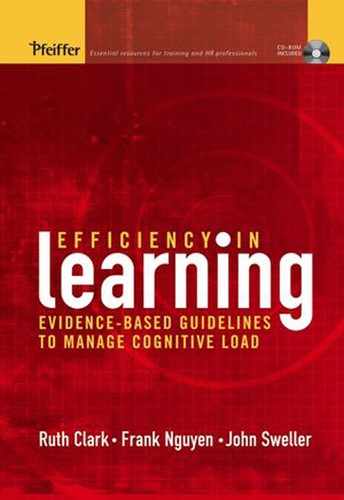IN PART 2 WE INCLUDE six chapters that summarize all of the proven ways you can reduce extraneous (irrelevant) and intrinsic cognitive load. When learners are novice and the skills are complex, you should keep extraneous cognitive load low and manage intrinsic cognitive load in order to free up working memory for learning. Many of the proven techniques that reduce extraneous cognitive load involve best ways to use the basic communication tools of visuals, text, and audio to present your content. Effective use of graphics, audio, and text can make the best use of limited working memory resources by:
Dividing content between the visual and auditory centers in working memory
Focusing attention to important content elements and avoiding split attention
Minimizing unnecessary or redundant content or presentation modes
Providing external memory supplements with performance aids
In addition to these methods, you can reduce extraneous cognitive load by replacing some practice exercises with demonstrations, also called worked examples. Studying worked examples leads to learning with less extraneous (unproductive) mental effort than that required by solving practice problems. As a result, learning is more efficient.
Intrinsic cognitive load originates from the complexity of your instructional content. You can reduce intrinsic cognitive load by segmenting the content so that learners are exposed to supporting knowledge separate from task steps or process stages. In that way learners are introduced to small increments of new content gradually. Likewise, when learners can control the rate at which they access instruction, such as in self-paced e-learning or when reading a text, intrinsic load can be managed by the learner. In contrast, instructionally paced learning environments, such as classroom or synchronous e-learning sessions, will impose higher cognitive load and load reduction techniques must be used to compensate.
Read | To Find Out How to |
Chapter 3. Use Visuals and Audio Narration | Use diagrams to represent spatial information in training materials and working aids Use diagrams to build deeper understanding Explain diagrams efficiently with audio narration |
Chapter 4. Focus Attention and Avoid Split Attention | Focus attention with signals and cues Avoid split attention by integrating content on pages or screens Avoid split attention in computer training by integrating all content in a single delivery medium |
Chapter 5. Weed Your Training | Pare content down to essentials Eliminate extraneous visuals, text, and audio Eliminate redundancy in content delivery modes |
Chapter 6. Provide External Memory Support | Supplement memory with performance aids Design efficient performance aids |
Chapter 7. Use Segmenting, Sequencing, and Learner Pacing | Segment lesson content so that learners receive content gradually Identify cognitive load risks of whole-task learning environments Identify the cognitive load associated with instructionally paced learning environments |
Chapter 8. Transition from Worked Examples | Replace some practice problems with worked examples and completion problems Use backwards fading to transition from worked examples to practice problems Display worked examples and completion problems in ways that avoid split attention |
Video Interview with John Sweller: Chapter Preview/Review
Chapter 3. Use Visuals and Audio Narration. The best techniques for display and explanation of spatial information using graphics and audio
Chapter 4. Optimize Attention. Methods to use to focus attention/avoid split attention; a discussion of the cognitive load imposed by note-taking and by split attention formats in computer training
Chapter 5. Weed Your Training. A definition of the redundancy effect followed by specific discussion of repetition versus redundancy, redundancy in computer training, and redundancy in instructor presentations
Chapter 7. Use Segmenting, Sequencing, and Learner Pacing. Techniques you can use to manage intrinsic cognitive load
Chapter 8. Transition from Worked Examples. Research on worked examples; how to adjust worked examples as learners gain expertise as well as formatting guidelines for worked examples
Sample Excel e-Lessons
Before: Overloaded Excel Web-Based Lesson. This asynchronous e-learning sample violates most of the guidelines for reducing extraneous cognitive load discussed in this part of the book.
John Sweller's commentary of the Overloaded Excel Web-Based Lesson specifies the cognitive load violations in this asynchronous e-learning sample.
After: Load-Managed Excel Web-Based Lesson. This asynchronous e-learning sample applies most of the guidelines for reducing extraneous cognitive load discussed in this part of the book.
John Sweller's commentary of the Load-Managed Excel Web-Based Lesson specifies the cognitive load guidelines exemplified in this asynchronous e-learning sample.
Virtual Classroom Example. This synchronous e-learning sample applies most of the guidelines for reducing extraneous cognitive load discussed in this part of the book.
Accelerate Expertise with Dual Modalities
Guideline 1: Use Diagrams to Optimize Performance on Tasks Requiring Spatial Manipulations
How Diagrams Promote Efficient Performance
Guideline 2: Use Diagrams to Promote Learning of Rules Involving Spatial Relationships
Applying the Research
Guideline 3: Use Diagrams to Help Learners Build Deeper Understanding
Are All Diagrams Equal?
The Psychology of Diagrams for Deeper Learning
Guideline 4: Explain Diagrams with Words Presented by Audio Narration
Applying the Research
When to Use Audio to Explain Visuals
The Delivery Medium Must Carry Audio
Back-Up Audio with Text to Accommodate Learners with Hearing Impairments
Use Audio to Explain High Complexity Content
Use Audio for Low Prior Knowledge Learners
Use Diagrams and Audio Only When Diagrams and/or Text Require Explanations
Use Text Rather than Audio When Learners Need Reference to Content
The Bottom Line
Using Audio to Describe Text Rather Than Diagrams
On the CD
John Sweller Video Interview
Sample Excel e-Lesson
